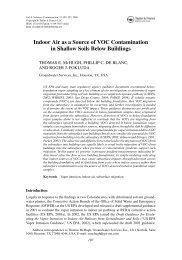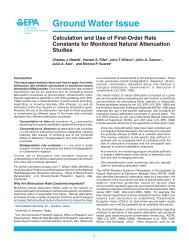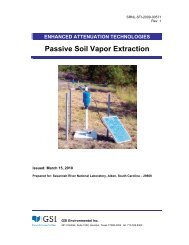direct hydrogen addition for the in-situ biodegradation of chlorinated
direct hydrogen addition for the in-situ biodegradation of chlorinated
direct hydrogen addition for the in-situ biodegradation of chlorinated
You also want an ePaper? Increase the reach of your titles
YUMPU automatically turns print PDFs into web optimized ePapers that Google loves.
Groundwater Services, Inc. Nov. 1997<br />
Introduction<br />
As a result <strong>of</strong> <strong>the</strong>ir widespread use as solvents, degreasers, and dry clean<strong>in</strong>g agents,<br />
chlor<strong>in</strong>ated aliphatic hydrocarbons (PCE, TCE, DCE, etc.) represent one <strong>of</strong> <strong>the</strong> most<br />
common and most persistent groups <strong>of</strong> contam<strong>in</strong>ants found <strong>in</strong> groundwater. While<br />
generally regarded as recalcitrant, chlor<strong>in</strong>ated hydrocarbons are known to undergo natural<br />
dechlor<strong>in</strong>ation <strong>in</strong> <strong>the</strong> field (Gossett and Z<strong>in</strong>der, 1996; Wiedemeier et al., <strong>in</strong> press).<br />
Typically, <strong>the</strong> rate <strong>of</strong> natural dechlor<strong>in</strong>ation is severely limited by <strong>the</strong> lack <strong>of</strong> adequate<br />
electron donor quantities. At sites where natural dechlor<strong>in</strong>ation is occurr<strong>in</strong>g, organic<br />
substrates such as aromatic hydrocarbons (BTEX), landfill leachate, or o<strong>the</strong>r nonchlor<strong>in</strong>ated<br />
organics undergo slow fermentation and produce dissolved <strong>hydrogen</strong>. The<br />
<strong>hydrogen</strong> is <strong>the</strong>n rapidly utilized as an electron donor by naturally-occurr<strong>in</strong>g bacteria to<br />
achieve reductive dechlor<strong>in</strong>ation <strong>of</strong> chlor<strong>in</strong>ated compounds <strong>in</strong> <strong>the</strong> subsurface. In-<strong>situ</strong><br />
bioremediation via <strong>direct</strong> <strong>hydrogen</strong> <strong>addition</strong> represents an extension <strong>of</strong> <strong>the</strong>se naturallyoccurr<strong>in</strong>g<br />
processes. Direct <strong>hydrogen</strong> <strong>addition</strong> simply elim<strong>in</strong>ates <strong>the</strong> rate-limit<strong>in</strong>g step<br />
(i.e., slow fermentation) and provides <strong>the</strong> naturally-occurr<strong>in</strong>g dechlor<strong>in</strong>at<strong>in</strong>g bacteria with<br />
substantive quantities <strong>of</strong> <strong>the</strong> key growth substrate: <strong>hydrogen</strong>.<br />
The advantages <strong>of</strong> <strong>the</strong> <strong>hydrogen</strong> delivery process are summarized below:<br />
¥ Direct <strong>hydrogen</strong> <strong>addition</strong> is an extension <strong>of</strong> naturally-occurr<strong>in</strong>g processes<br />
occurr<strong>in</strong>g at thousands <strong>of</strong> chlor<strong>in</strong>ated solvent sites across <strong>the</strong> county (Wilson,<br />
1997). This greatly <strong>in</strong>creases <strong>the</strong> likelihood <strong>of</strong> success.<br />
¥ Hydrogen <strong>addition</strong> provides highly favorable stoichiometry and can tolerate<br />
process <strong>in</strong>efficiencies.<br />
¥ Hydrogen <strong>addition</strong> will lead to an <strong>in</strong>crease <strong>in</strong> <strong>the</strong> efficiency <strong>of</strong> dechlor<strong>in</strong>ation over<br />
time.<br />
¥ Hydrogen is a very <strong>in</strong>expensive method <strong>of</strong> chlor<strong>in</strong>ated solvent remediation.<br />
¥ Hydrogen is a commonly used <strong>in</strong>dustrial gas and can be used safely <strong>for</strong><br />
remediation.<br />
¥ Hydrogen does not leave any environmentally harmful residue <strong>in</strong> <strong>the</strong> subsurface<br />
and does not require any surface treatment system.<br />
¥ Direct <strong>hydrogen</strong> <strong>addition</strong> is a much simpler and more flexible process than o<strong>the</strong>r<br />
treatment approaches <strong>for</strong> chlor<strong>in</strong>ated solvents (e.g., pump-and-treat, surfactant<br />
<strong>addition</strong>, etc.).<br />
Biodegradation <strong>of</strong> Chlor<strong>in</strong>ated Organic Compounds<br />
Generally, organic compounds represent potential electron donors to support microbial<br />
metabolism (e.g., <strong>the</strong> oxidation <strong>of</strong> BTEX compounds). However, halogenated compounds<br />
such as chlor<strong>in</strong>ated solvents can act as electron acceptors and thus become reduced <strong>in</strong> <strong>the</strong><br />
reductive dehalogenation process. Specifically, dehalogenation by reduction is <strong>the</strong><br />
replacement <strong>of</strong> a halogen such as chloride, bromide, or fluoride on an organic molecule by<br />
<strong>hydrogen</strong> as described by <strong>the</strong> follow<strong>in</strong>g half-reaction:<br />
2






